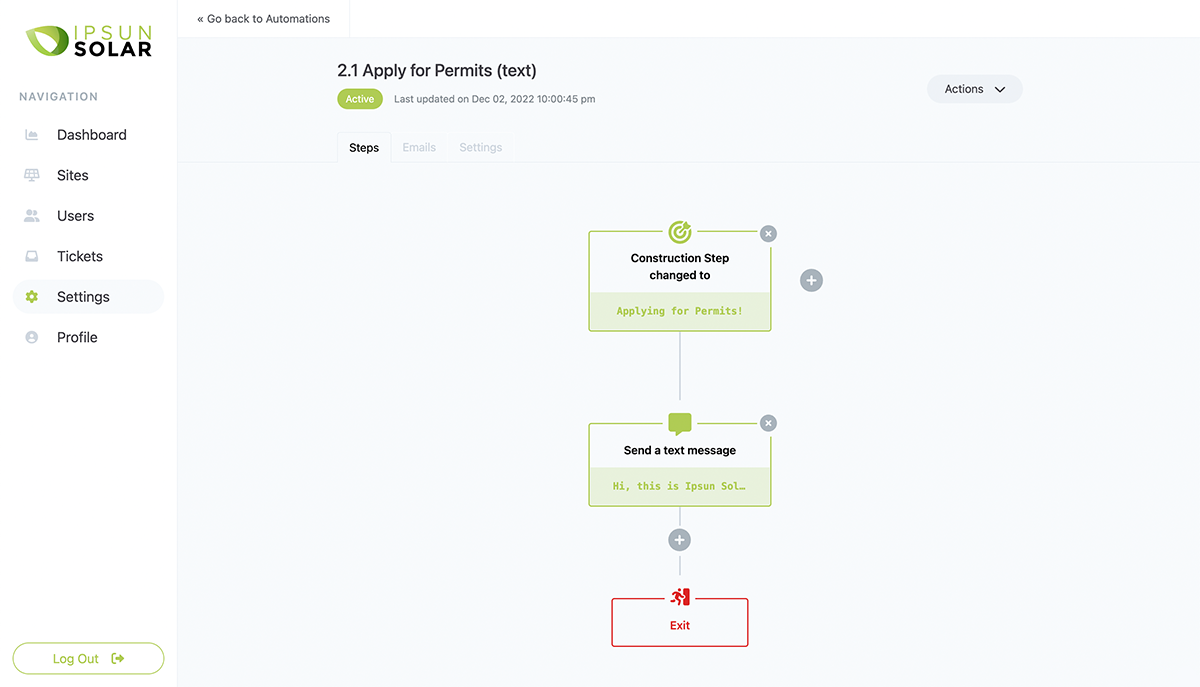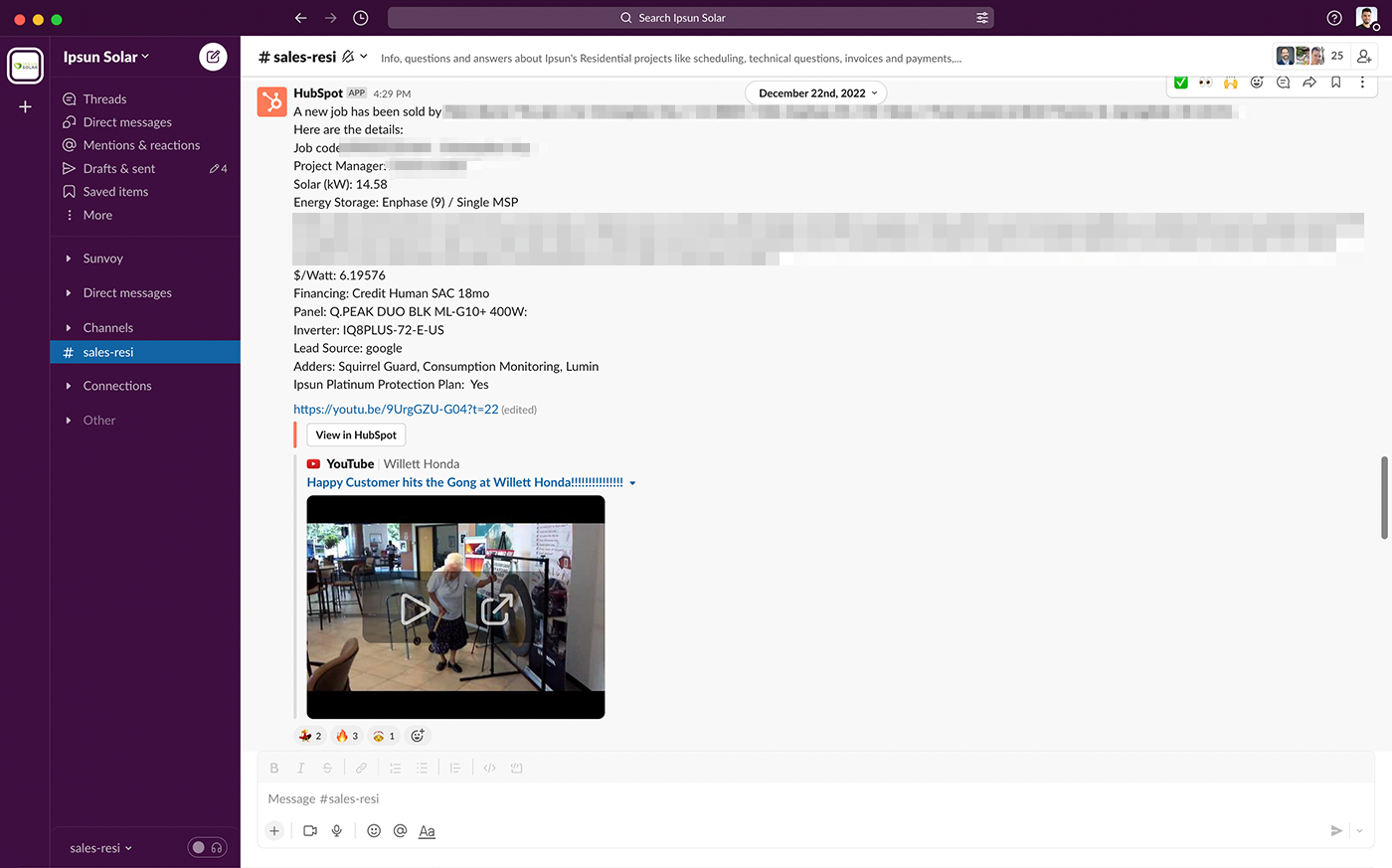
Ten Automations You Can Create Today to Improve Your Solar Business
If you run a solar business (like we do), then you probably spend half your time trying to automate the countless number of tasks that are in front of you every day.
Of course, not everybody has access to a developer to build custom automations, create a specialized code-driven CRM that automates every task or a powerful solar automation portal like Sunvoy. Which is one of the reasons why you might have seen us recommending HubSpot as the best CRM for solar installers alongside a powerful Customer Portal like Sunvoy.
That being said, many of our top ten automations you’ll probably be able to use in your CRM of choice, so we recommend considering these to boost the productivity of your team and increase your referrals.
1. Net Promoter Score
Ask for a Net Promoter Score as your projects are ongoing and completed.
Okay, we know that the NPS isn’t the be-all-end-all metric, but it’s widely accepted and a reasonable place to start.
Ask for a quick NPS score from your customers to see how you’re doing at every stage of your projects, which for us is after the design/engineering phase, permitting, installation, and commissioning.
Leave an area for customers to write feedback so that you can spot gaps in your process and workflows to be identified as soon as that pain point is felt by your customer. Catching issues proactively can even prevent getting negative reviews before they get written and hard to remove.
And maybe the best thing:
If you get a positive response ask them immediately to leave a public online review.
2. Keep customers updated
Send regular updates to your customers as they progress through their project development.
There is nothing worse than waiting 3-6 months for a home improvement and having no idea what the current status is.
You can set your CRM or Sunvoy to send regular updates to your customers as they progress through the pipeline, so they are up to date.

This will also make them less likely to reach out to you directly and keep them happy throughout the process as the majority of bad reviews boils down to one thing:
Bad communication.
3. Follow up on prospects
If you’ve presented a solar proposal more than 30 days ago, send those prospective customers a reminder asking them to book an appointment with you to discuss any changes to pricing, equipment, or incentives (which really do change all the time).
Include a link to the salesperson’s calendar so they can book a time at their own convenience.
This is as well the perfect opportunity to detail some of the services that might make your company unique to other low quality offerings in the market.
4. Reward Referral Leads
Send out a THNKS gift card for a free Starbucks coffee every time you receive a referral lead.
It’s a cheap and easy way to say thank you for the leads that come with the highest conversion rates.
It also provides immediate positive feedback. While you can't guarantee that you close each referral and always pay out the comission, this way you can at least guarantee that your referrers get a nice little reward immediately no matter if the referral actually ends up going solar.
5. Educate prospective customers
Send drip campaigns to your different types of solar customers:
- environmentally-focused
- bottom line savers
- analytics, etc.
If you’re interested primarily in saving the planet and couldn’t care less about return on investment, you’re going to be better served by educational emails around the impact of your solar system to the Earth, than someone who wants the latest and greatest technology.
Make sure these customers get the content that is going to best guide them through their solar journey.
6. Create tasks for your team members
Tasks, tasks and more tasks.
Make sure that all of your solar team members get automated tasks when deals enter their respective stages.
For instance, when a project manager needs to reach out to a customer after a sale is made, make sure that task is automated at the first stage, and when a commission call needs to be made at the end, make sure there is a task at the last stage.
Sounds obvious, but every stage should have at least 1-3 tasks for all the team members to ensure a smooth customer experience and that nobody drops the ball at a critical moment.
7. Rally your troops
Send a message to the whole company when a sale is made.
This may seem trivial, but in an age of remote work, there are no gongs in the office to hit when a sale is made.
Ipsun Solar created an automation that notifies the whole team of a new sale, including the project stats and unique elements.
It’s a nice little hit of dopamine, and gets everyone revved up for new work.

8. Duplicate Customer Info where necessary
One of the goals of Sunvoy is to never have solar installers write the name and address of their customers more than one time - and only in their CRM.
While this is an ambitious goal, since solar installers commonly are forced to enter this information in anywhere from 10-15 different platforms, we do believe it’s achievable.
Today, we have an automation at Ipsun Solar that takes the homeowner’s name and address and ports it to our ERP (for accounting and inventory), Sunvoy (for customer experience and fleet management) and _TSheets _(for time tracking)*.
Once it's within Sunvoy we can as well automatically create activations within Enphase (for site creation and provisioning) or order Eagleview Reports (for roof measurements). With an ever growing list of integrations Sunvoy really becomes a key piece for accomplishing our goal of imroving employee satisfaction and productivity by automating and killing mudane day to day tasks.
If you don't want to use Sunvoy, you can consider as well an integration tool like Celigo to automate and reduce redundancy in your processes with respect to data management. Although it might make things worse as you add yet another piece to your already likely fragmented IT landscape.
9. Automate Sales Follow up
The number one sales automation that you should be aware of are email sequences.
Sequences are automated emails that look and feel personalized but are really automated based on the stage of the customer’s journey.
These can be as many emails as desired with different subjects and content in each, and any amount of delays or tasks in between.
These emails are meant to remind the customer of you and your company, the value you bring and what they can expect from you.
10. Automated reporting
Automate your reporting so that you don’t have to manually update information in real time.
With HubSpot, you can create up to 500 reports that give you all kinds of information about your business from sales volumes over time to conversion rates by lead source, and it’s all automated so you don’t have to worry about tracking down the information.
In fact, we wrote a whole in-depth blog post about our favorite reports!
If you want to dig deeper into the automation potential you are currently leaving on the table, or simply get a second set of eyes on your current setup make sure to jump on a free audit call. We have conducted hundreds of these with some of the largest solar installers in the country over the past year and almost always discover some new and exciting opportunities:
From "aha" to "oh crap", we're sharing everything on our journey to help install 100,000 residential solar systems per year.
We're learning a lot and so will you.
Residential solar systems installed through Sunvoy in the past year:
Real time metrics tracked bysunvoy
Before starting Sunvoy, Joe was the Co-Founder and COO of a top residential solar installer in Washington DC with 60+ employees and $12M+ in annual revenue. Now he helps solar companies scale far beyond through Sunvoy.
